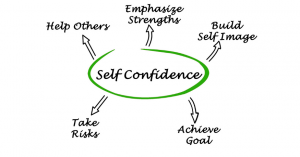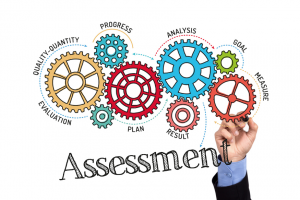
Have you ever wanted to do something and the “little voice in your head” said, “NO! You’ll fail! You can’t! You’re not smart enough! You’re too old! You don’t have what it takes to succeed?”
Everyone has self-doubts. They occur when fear or uncertainty creeps in! But don’t let your self-doubt become the predictor of your goals, career choices, or leadership.
Building confidence is an inside job and erases self-doubt. It’s developing a belief and a trust in yourself each day … where you are … right now.
7 Ways to Erase Self-Doubt and Build Confidence
- Replace Negative Self-Talk with Your Brags! Internal mind chatter often gets in everyone’s way, especially when attempting something new. To overcome this, complete the Brag! work in It’s Time to Brag! Business Edition. Wow! Look at what you’ve already achieved! Remember, no matter what you’ve accomplished in life … and you’ve already accomplished a lot … self-doubt can sabotage your career if you allow it! So now, before you second-guess yourself, again, offer your idea, manage team conflict, and/or ask your boss for that promotion and pay raise!
- Banish the Fear of Feeling You’re Not Good Enough. We all experience the “Imposter Syndrome” when not feeling confident, especially women. This happens regardless of all the credentials and other awards you’ve won! When it occurs, talk it out with your executive coach. Uncover the real reason for your fear (e.g., getting your boss’s approval, managing a difficult team member, hiring the right person, etc.).
- Be Willing to Learn Something New. Yes, everyone started their career “not knowing how to do or accomplish something!” However, the ones that succeeded were willing to set aside their ego, admit they didn’t know, and learn the basics. They were also ready to practice and become masters while working through mistakes! Remember, when you set aside your ego, you learn at a faster and more advanced level!
- It Doesn’t Need to be Perfect … Just Very Good. This can be difficult for successful people to grasp … and, it doesn’t mean overlooking mistakes. Also, it doesn’t mean accepting mediocrity. Remember, perfectionism creates unnecessary stress, team conflict, and missed milestones. So relax, trust in the process, and allow your team to work their magic!
- Use the “Rule of 3” to Make the Best Decision You Can. Create 3 must-haves for your project, new vehicle, or next job. Now, get three different quotes or create three options for fulfillment. When selecting a book editor, I remember I found three viable candidates and had each submit their proposal. Then, I decided on the one that met my criteria. Remember, the cheapest isn’t always the best one!
- Accept Negative Feedback Graciously. When you receive negative feedback, instead of allowing self-doubt to take hold, get the specifics of the issue. Be open to feedback. It’s how you improve. Ask, “What were your 2 specific concerns and why are these important?” Listen and learn. Now, incorporate these as appropriate. If you’re not willing to learn from negative feedback, your self-doubt will win!
- Just Because You Fail, It Doesn’t Mean You Should Stop Trusting or Believing in Yourself. Of course, there will be times you fail (we all do). But it may be time to get real. If you’re unwilling to take focused-actions designed to achieve the results, work with your executive coach for other options. For example, if you’re reluctant to sell, being a financial planner will not be a successful career choice today.
©Jeannette Seibly 2021 All Rights Reserved
Jeannette Seibly is The Leadership Results Coach. She has guided the creation of three millionaires and countless 6-figure income professionals for almost 30 years. Her brags include being an award-winning international executive and family business management consultant, and keynote speaker. Recently, she was able to add another brag. She became an international Amazon Bestselling author of, The Old Wooden Rocker. Have questions? Need a speaker or facilitator? Contact Jeannette for a confidential conversation.
A Note from Jeannette about erasing self-doubt. Everyone experiences self-doubt when faced with uncertainty, especially when attempting something new. Learning to erase these fears builds confidence now and guides you in future endeavors. Are you stuck and uncertain where to begin? Contact me for a confidential conversation.
Want to be an influencer? Have your ideas heard and valued by your boss and team? Get your Eight Tips to Increase Your Ability to Influence


 Jeannette Seibly is The Leadership Results Coach. She has guided the creation of three millionaires and countless 6-figure income professionals for almost 30 years. Her brags include being an award-winning executive coach, management consultant, and keynote speaker. Recently, she became an Amazon Bestselling author of her first novel,
Jeannette Seibly is The Leadership Results Coach. She has guided the creation of three millionaires and countless 6-figure income professionals for almost 30 years. Her brags include being an award-winning executive coach, management consultant, and keynote speaker. Recently, she became an Amazon Bestselling author of her first novel, 




 Jeannette Seibly is The Leadership Results Coach. During the past 29 years, she has guided the creation of three millionaires and countless 6-figure income professionals. Her brags also include being an award-winning executive coach, management consultant, and keynote speaker. If you’re struggling to get unstuck, now is a great time to
Jeannette Seibly is The Leadership Results Coach. During the past 29 years, she has guided the creation of three millionaires and countless 6-figure income professionals. Her brags also include being an award-winning executive coach, management consultant, and keynote speaker. If you’re struggling to get unstuck, now is a great time to 

